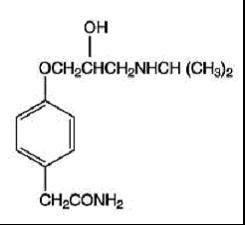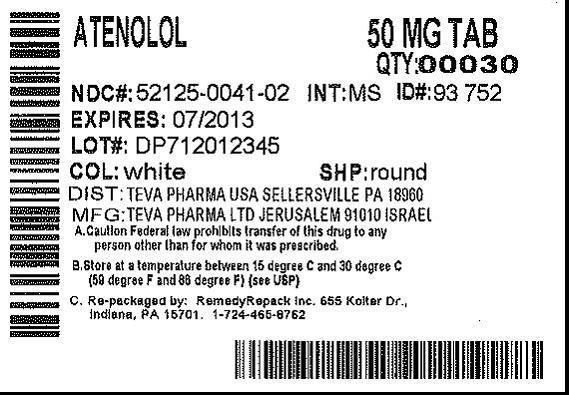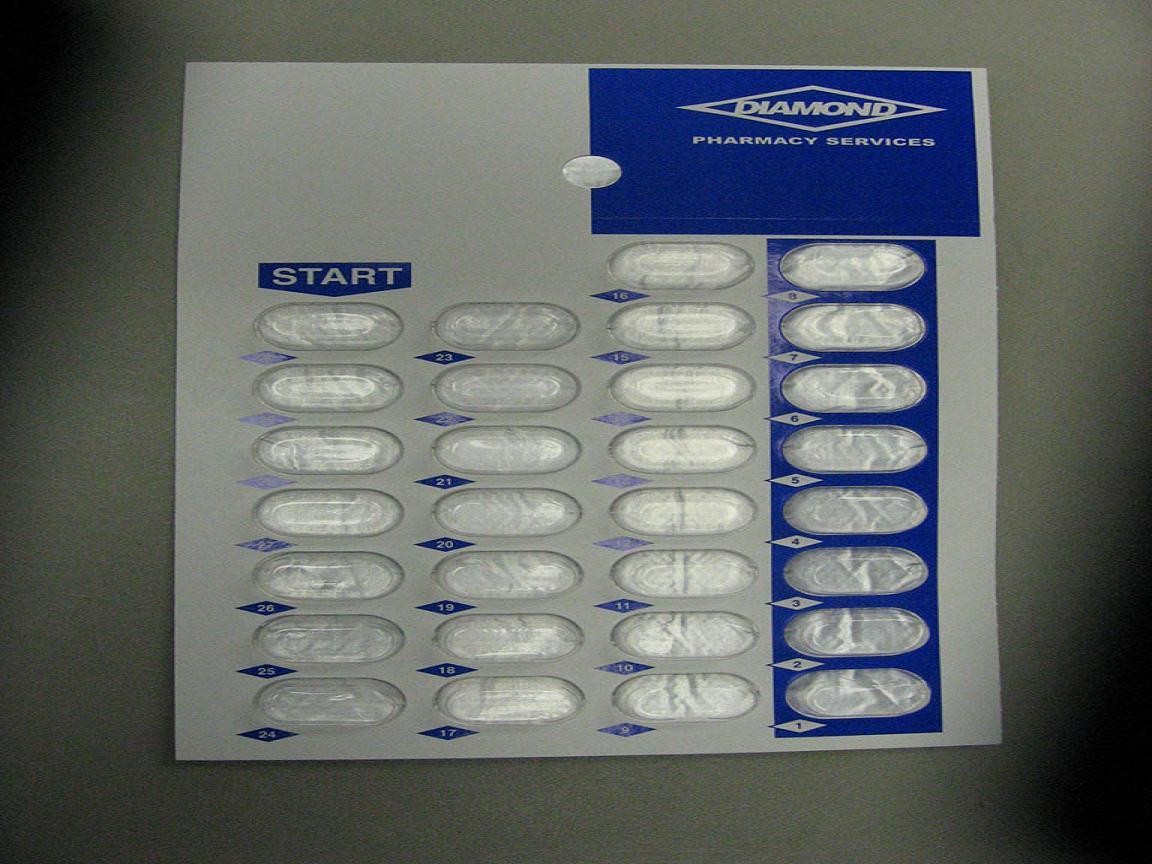Atenolol
FULL PRESCRIBING INFORMATION: CONTENTS*
- CESSATION OF THERAPY WITH ATENOLOL
- ATENOLOL DESCRIPTION
- CLINICAL PHARMACOLOGY
- INDICATIONS & USAGE
- ATENOLOL CONTRAINDICATIONS
- WARNINGS
- PRECAUTIONS
- DRUG INTERACTIONS
- CARCINOGENESIS & MUTAGENESIS & IMPAIRMENT OF FERTILITY
- ANIMAL TOXICOLOGY
- USAGE IN PREGNANCY
- NURSING MOTHERS
- PEDIATRIC USE
- GERIATRIC USE
- ATENOLOL ADVERSE REACTIONS
- OVERDOSAGE
- DOSAGE & ADMINISTRATION
- HOW SUPPLIED
- STORAGE AND HANDLING
- PACKAGE LABEL.PRINCIPAL DISPLAY PANEL SECTION
FULL PRESCRIBING INFORMATION
ATENOLOL DESCRIPTION

CLINICAL PHARMACOLOGY
Atenolol is a beta1-selective (cardioselective) beta-adrenergic receptor blocking agent without membrane stabilizing or intrinsic sympathomimetic (partial agonist) activities. This preferential effect is not absolute, however, and at higher doses, atenolol inhibits beta2-adrenoreceptors, chiefly located in the bronchial and vascular musculature.Pharmacokinetics and Metabolism
In man, absorption of an oral dose is rapid and consistent but incomplete. Approximately 50% of an oral dose is absorbed from the gastrointestinal tract, the remainder being excreted unchanged in the feces. Peak blood levels are reached between two (2) and four (4) hours after ingestion. Unlike propranolol or metoprolol, but like nadolol, atenolol undergoes little or no metabolism by the liver, and the absorbed portion is eliminated primarily by renal excretion. Over 85% of an intravenous dose is excreted in urine within 24 hours compared with approximately 50% for an oral dose. Atenolol also differs from propranolol in that only a small amount (6% to 16%) is bound to proteins in the plasma. This kinetic profile results in relatively consistent plasma drug levels with about a fourfold interpatient variation.
DOSAGE AND ADMINISTRATION).
Pharmacodynamics
In standard animal or human pharmacological tests, beta-adrenoreceptor blocking activity of atenolol has been demonstrated by: (1) reduction in resting and exercise heart rate and cardiac output, (2) reduction of systolic and diastolic blood pressure at rest and on exercise, (3) inhibition of isoproterenol induced tachycardia, and (4) reduction in reflex orthostatic tachycardia.
A significant beta-blocking effect of atenolol, as measured by reduction of exercise tachycardia, is apparent within one hour following oral administration of a single dose. This effect is maximal at about 2 to 4 hours, and persists for at least 24 hours. Maximum reduction in exercise tachycardia occurs within 5 minutes of an intravenous dose. For both orally and intravenously administered drug, the duration of action is dose related and also bears a linear relationship to the logarithm of plasma atenolol concentration. The effect on exercise tachycardia of a single 10 mg intravenous dose is largely dissipated by 12 hours, whereas beta-blocking activity of single oral doses of 50 mg and 100 mg is still evident beyond 24 hours following administration. However, as has been shown for all beta-blocking agents, the antihypertensive effect does not appear to be related to plasma level.
In normal subjects, the beta1 selectivity of atenolol has been shown by its reduced ability to reverse the beta2-mediated vasodilating effect of isoproterenol as compared to equivalent beta-blocking doses of propranolol. In asthmatic patients, a dose of atenolol producing a greater effect on resting heart rate than propranolol resulted in much less increase in airway resistance. In a placebo controlled comparison of approximately equipotent oral doses of several beta blockers, atenolol produced a significantly smaller decrease of FEV1 than nonselective beta blockers such as propranolol and, unlike those agents, did not inhibit bronchodilation in response to isoproterenol.
Consistent with its negative chronotropic effect due to beta blockade of the SA node, atenolol increases sinus cycle length and sinus node recovery time. Conduction in the AV node is also prolonged. Atenolol is devoid of membrane stabilizing activity, and increasing the dose well beyond that producing beta blockade does not further depress myocardial contractility. Several studies have demonstrated a moderate (approximately 10%) increase in stroke volume at rest and during exercise.
In controlled clinical trials, atenolol, given as a single daily oral dose, was an effective antihypertensive agent providing 24 hour reduction of blood pressure. Atenolol has been studied in combination with thiazide-type diuretics, and the blood pressure effects of the combination are approximately additive. Atenolol is also compatible with methyldopa, hydralazine, and prazosin, each combination resulting in a larger fall in blood pressure than with the single agents. The dose range of atenolol is narrow and increasing the dose beyond 100 mg once daily is not associated with increased antihypertensive effect. The mechanisms of the antihypertensive effects of beta-blocking agents have not been established. Several possible mechanisms have been proposed and include: (1) competitive antagonism of catecholamines at peripheral (especially cardiac) adrenergic neuron sites, leading to decreased cardiac output, (2) a central effect leading to reduced sympathetic outflow to the periphery, and (3) suppression of renin activity. The results from long-term studies have not shown any diminution of the antihypertensive efficacy of atenolol with prolonged use.
By blocking the positive chronotropic and inotropic effects of catecholamines and by decreasing blood pressure, atenolol generally reduces the oxygen requirements of the heart at any given level of effort, making it useful for many patients in the long-term management of angina pectoris. On the other hand, atenolol can increase oxygen requirements by increasing left ventricular fiber length and end diastolic pressure, particularly in patients with heart failure.
In a multicenter clinical trial (ISIS-1) conducted in 16,027 patients with suspected myocardial infarction, patients presenting within 12 hours (mean = 5 hours) after the onset of pain were randomized to either conventional therapy plus atenolol (n = 8,037), or conventional therapy alone (n = 7,990). Patients with a heart rate of < 50 bpm or systolic blood pressure < 100 mm Hg, or with other contraindications to beta blockade were excluded. Thirty-eight percent of each group were treated within 4 hours of onset of pain. The mean time from onset of pain to entry was 5.02.7 hours in both groups. Patients in the atenolol group were to receive atenolol I.V. injection 5 to 10 mg given over 5 minutes plus atenolol tablets 50 mg every 12 hours orally on the first study day (the first oral dose administered about 15 minutes after the IV dose) followed by either atenolol tablets 100 mg once daily or atenolol tablets 50 mg twice daily on days 2 to 7. The groups were similar in demographic and medical history characteristics and in electrocardiographic evidence of myocardial infarction, bundle branch block, and first degree atrioventricular block at entry.
Despite the large size of the ISIS-1 trial, it is not possible to identify clearly subgroups of patients most likely or least likely to benefit from early treatment with atenolol. Good clinical judgment suggests, however, that patients who are dependent on sympathetic stimulation for maintenance of adequate cardiac output and blood pressure are not good candidates for beta blockade. Indeed, the trial protocol reflected that judgment by excluding patients with blood pressure consistently below 100 mm Hg systolic. The overall results of the study are compatible with the possibility that patients with borderline blood pressure (less than 120 mm Hg systolic), especially if over 60 years of age, are less likely to benefit.
The mechanism through which atenolol improves survival in patients with definite or suspected acute myocardial infarction is unknown, as is the case for other beta blockers in the postinfarction setting. Atenolol, in addition to its effects on survival, has shown other clinical benefits including reduced frequency of ventricular premature beats, reduced chest pain, and reduced enzyme elevation.
Atenolol Geriatric Pharmacology
In general, elderly patients present higher atenolol plasma levels with total clearance values about 50% lower than younger subjects. The half-life is markedly longer in the elderly compared to younger subjects. The reduction in atenolol clearance follows the general trend that the elimination of renally excreted drugs is decreased with increasing age.
INDICATIONS & USAGE
HypertensionAtenolol tablets USP are indicated in the management of hypertension. They may be used alone or concomitantly with other antihypertensive agents, particularly with a thiazide-type diuretic.
Angina Pectoris Due to Coronary Atherosclerosis
Atenolol tablets USP are indicated for the long-term management of patients with angina pectoris.
Acute Myocardial Infarction
Atenolol tablets USP are indicated in the management of hemodynamically stable patients with definite or suspected acute myocardial infarction to reduce cardiovascular mortality. Treatment can be initiated as soon as the patient's clinical condition allows (see DOSAGE AND ADMINISTRATION, CONTRAINDICATIONS, and WARNINGS). In general, there is no basis for treating patients like those who were excluded from the ISIS-1 trial (blood pressure less than 100 mm Hg systolic, heart rate less than 50 bpm) or have other reasons to avoid beta blockade. As noted above, some subgroups (e.g., elderly patients with systolic blood pressure below 120 mm Hg) seemed less likely to benefit.
ATENOLOL CONTRAINDICATIONS
WARNINGS).Atenolol tablets are contraindicated in those patients with a history of hypersensitivity to the atenolol or any of the drug productcomponents.
WARNINGS
Cardiac FailureSympathetic stimulation is necessary in supporting circulatory function in congestive heart failure, and beta blockade carries the potential hazard of further depressing myocardial contractility and precipitating more severe failure.
In patients with acute myocardial infarction, cardiac failure which is not promptly and effectively controlled by 80 mg of intravenous furosemide or equivalent therapy is a contraindication to beta-blocker treatment.
In Patients Without a History of Cardiac Failure
Continued depression of the myocardium with beta-blocking agents over a period of time can, in some cases, lead to cardiac failure. At the first sign or symptom of impending cardiac failure, patients should be treated appropriately according to currently recommended guidelines, and the response observed closely. If cardiac failure continues despite adequate treatment, atenolol should be withdrawn (seeDOSAGE AND ADMINISTRATION).
Cessation of Therapy With Atenolol
Patients with coronary artery disease, who are being treated with atenolol, should be advised against abrupt discontinuation of therapy. Severe exacerbation of angina and the occurrence of myocardial infarction and ventricular arrhythmias have been reported in angina patients following the abrupt discontinuation of therapy with beta blockers. The last two complications may occur with or without preceding exacerbation of the angina pectoris. As with other beta blockers, when discontinuation of atenolol is planned, the patients should be carefully observed and advised to limit physical activity to a minimum. If the angina worsens or acute coronary insufficiency develops, it is recommended that atenolol be promptly reinstituted, at least temporarily. Because coronary artery disease is common and may be unrecognized, it may be prudent not to discontinue atenolol therapy abruptly even in patients treated only for hypertension (seeDOSAGE AND ADMINISTRATION).
Concomitant Use of Calcium Channel Blockers
Bradycardia and heart block can occur and the left ventricular end diastolic pressure can rise when beta-blockers are administered with verapamil or diltiazem. Patients with preexisting conduction abnormalities or left ventricular dysfunction are particularly susceptible (seePRECAUTIONS).
Bronchospastic Disease
PATIENTS WITH BRONCHOSPASTIC DISEASE SHOULD, IN GENERAL, NOT RECEIVE BETA BLOCKERS. Because of its relative beta1 selectivity, however, atenolol may be used with caution in patients with bronchospastic disease who do not respond to, or cannot tolerate, other antihypertensive treatment. Since beta1 selectivity is not absolute, the lowest possible dose of atenolol should be used with therapy initiated at 50 mg and a beta2-stimulating agent (bronchodilator) should be made available. If dosage must be increased, dividing the dose should be considered in order to achieve lower peak blood levels.
Major Surgery
Chronically administered beta-blocking therapy should not be routinely withdrawn prior to major surgery; however, the impaired ability of the heart to respond to reflex adrenergic stimuli may augment the risks of general anesthesia and surgical procedures.
Diabetes and Hypoglycemia
Atenolol should be used with caution in diabetic patients if a beta-blocking agent is required. Beta blockers may mask tachycardia occurring with hypoglycemia, but other manifestations such as dizziness and sweating may not be significantly affected. At recommended doses atenolol does not potentiate insulin-induced hypoglycemia and, unlike nonselective beta blockers, does not delay recovery of blood glucose to normal levels.
Thyrotoxicosis
Beta-adrenergic blockade may mask certain clinical signs (e.g., rachycardia) of hyperthyroidism. abrupt withdrawal of beta blockade might precipitate a thyroid storm; therefore, patients suspected of developing thyrotoxicosis from whom atenolol theapy is to be withdrawn should be monitored closely (seeDOSAGE AND ADMINISTRATION).
Untreated Pheochromocytoma
Atenolol should not be given to patients with untreated pheochromocytoma.
Pregnancy and Fetal Injury
Atenolol can cause fetal harm when administered to a pregnant woman. Atenolol crosses the placental barrier and appears in cord blood. Administration of atenolol, starting in the second trimester of pregnancy, has been associated with the birth of infants that are small for gestational age. No studies have been performed on the use of atenolol in the first trimester and the possibility of fetal injury cannot be excluded. If this drug is used during pregnancy, or if the patient becomes pregnant while taking this drug, the patient should be apprised of the potential hazard to the fetus.
Neonates born to mothers who are receiving atenolol at parturition or breast-feeding may be at risk for hypoglycemia and bradycardia. Caution should be exercised when atenolol is administered during pregnancy or to a woman who is breast-feeding (seePRECAUTIONS, Nursing Mothers).
Atenolol has been shown to produce a dose-related increase in embryo/fetal resorptions in rats at doses equal to or greater than 50 mg/kg/day or 25 or more times the maximum recommended human antihypertensive dose.* Although similar effects were not seen in rabbits, the compound was not evaluated in rabbits at doses above 25 mg/kg/day or 12.5 times the maximum recommended human antihypertensive dose.*
* Based on the maximum dose of 100 mg/day in a 50 kg patient.
PRECAUTIONS
GeneralPatients already on a beta blocker must be evaluated carefully before atenolol is administered. Initial and subsequent atenolol dosages can be adjusted downward depending on clinical observations including pulse and blood pressure. Atenolol may aggravate peripheral arterial circulatory disorders.
Impaired Renal Function
The drug should be used with caution in patients with impaired renal function (seeDOSAGE AND ADMINISTRATION).
DRUG INTERACTIONS
WARNINGS).
Disopyramide is a Type I antiarrhythmic drug with potent negative inotropic and chronotropic effects. Disopyramide has been associated with severe bradycardia, asystole and heart failure when administered with beta blockers.
Amiodarone is an antiarrhythmic agent with negative chronotropic properties that may be additive to those seen with beta blockers.
Beta blockers may exacerbate the rebound hypertension which can follow the withdrawal of clonidine. If the two drugs are coadministered, the beta blocker should be withdrawn several days before the gradual withdrawal of clonidine. If replacing clonidine by beta-blocker therapy, the introduction of beta blockers should be delayed for several days after clonidine administration has stopped.
Concomitant use of prostaglandin synthase inhibiting drugs, e.g., indomethacin, may decrease the hypotensive effects of beta blockers.
Information on concurrent usage of atenolol and aspirin is limited. Data from several studies, i.e., TIMI-II, ISIS-2, currently do not suggest any clinical interaction between aspirin and beta blockers in the acute myocardial infarction setting.
While taking beta blockers, patients with a history of anaphylactic reaction to a variety of allergens may have a more severe reaction on repeated challenge, either accidental, diagnostic or therapeutic. Such patients may be unresponsive to the usual doses of epinephrine used to treat the allergic reaction.
Both digitalis glycosides and beta-blockers slow atrioventricular conduction and decrease heart rate. Concomitant use can increase the risk of bradycardia.
CARCINOGENESIS & MUTAGENESIS & IMPAIRMENT OF FERTILITY
ANIMAL TOXICOLOGY
USAGE IN PREGNANCY
Teratogenic EffectsPregnancy category D
SeeWARNINGS, Pregnancy and Fetal Injury.
NURSING MOTHERS
WARNINGS, Pregnancy and Fetal Injury).
PEDIATRIC USE
GERIATRIC USE
CLINICAL PHARMACOLOGYINDICATIONS AND USAGE).
ATENOLOL ADVERSE REACTIONS
Acute Myocardial Infarction
Reasons for Reduced Dosage
*
*
POTENTIAL ADVERSE EFFECTS
Hematologic
Allergic
Central Nervous System
Reversible mental depression progressing to catatonia; an acute reversible syndrome characterized by disorientation of time and place; short-term memory loss; emotional lability with slightly clouded sensorium; and, decreased performance on neuropsychometrics.
Gastrointestinal
Other
Miscellaneous
DOSAGE AND ADMINISTRATION).
OVERDOSAGE
DOSAGE & ADMINISTRATION
HypertensionAngina Pectoris
Acute Myocardial Infarction
Elderly Patients or Patients With Renal Impairment
Cessation of Therapy in Patients With Angina Pectoris
HOW SUPPLIED
STORAGE AND HANDLING
PACKAGE LABEL.PRINCIPAL DISPLAY PANEL SECTION


AtenololAtenolol TABLET
| ||||||||||||||||||||||||||||||||||||||||||||||||||||||||||||||||||||||||||
PLEASE, BE CAREFUL!
Be sure to consult your doctor before taking any medication!